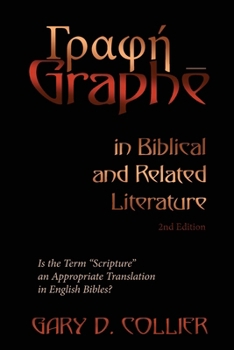G?af? Graphe in Biblical and Related Literature: Is the Term "Scripture" an Appropriate Translation in English Bibles?
This book addresses two questions:
What do the various documents of the Bible actually claim about the Greek word γραφή graphē, which is the main word in the NT that is translated into English as "Scripture"?Is this term "Scripture" an appropriate translation today?The word Scripture is one of the most important of all Christian terms. However, there is a disconnect between the way this word gets used by most today and the way the Greek word behind this translation actually gets used in ancient biblical and related literature. This is a problem across the board, from the most popular uses to academic discussions and reference tools. This new study takes a close look at the Greek term graphē in ancient literature (normally translated as Scripture in the NT), and offers a startling conclusion. The book is written for energetic and adventurous readers of the Bible and offers a model for how to do thorough word studies. It will challenge the basic way this word gets used today.
The book begins with a concern for "hallowed ground" strong beliefs about "scripture" in current usage. It then turns to tracing the word from Classical texts through the Apostolic Fathers. A great deal of attention is given to how translators in various texts have fallen into the practice of translating the word graphē as "writing" or "text", when not referring to texts in the Protestant biblical canon, but as "S/scripture" when referring to books within that canon, A great deal of attention is given to every biblical text which uses the word graphē and new translations are offered for each context. Major dictionaries (like TDNT and BDAG) on the word are challenged as offering biased or inaccurate distinctions for the word, and alternatives are offered. This directly affects English translations in use today, as well as common preaching and teaching habits.
The book has several appendices, including a select bibliography, a section on word study and resource fallacies, and general, author, and scripture indexes. The book offers a compact argument (just under 200 pages), is written in a non-dramatic style, and yet easy-to-read and access information.





